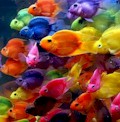When starting a new aquarium it is important to understand the nitrogen cycle. Many new aquarium owners jump into the hobby of fish keeping too quickly. Before purchasing fish, the aquarium must be cycled. This could take anywhere from twenty four hours to four weeks. In an established aquarium there are certain bacteria that help the breakdown of ammonia to nitrates, but they are not present in a new tank because they are generated from existing fish. If there are no existing fish, then there are no good bacteria.
The basic principle of the nitrogen cycle is this. Fish eat food and generate waste. That waste along with excess food and plant debris become ammonia in the aquarium. Ammonia is toxic to fish and needs to be broken down. That's why the nitrifying bacteria is important. This bacteria, turns the ammonia into nitrites which are more tolerable to fish than ammonia. Next, different nitrifying bacteria will turn the nitrites into nitrates, which are even less toxic to the fish and other aquarium life. The nitrates are collected and minimized by filters; however they will eventually accumulate in the tank. Regular water changes are required to remove the nitrates from the water.
It is important to set up and run an aquarium before any fish are introduced into the environment. Wash the tank and any substrate and decorations thoroughly with water. Don't use any soap. Fill the tank with de-chlorinated water and attach filters and lighting. Allow the tank to cycle until the water is no longer cloudy and sufficient P.H and water temperatures have been established.
Now it is time to purchase the fish! Buy hardy fish such as danios, barb, gouramis, and live bearers. They should be able to withstand the high nitrite levels and ammonia in the new aquarium. Only introduce about four fish at a time. Float the fish in the bag in the aquarium for about fifteen minutes before adding them to the tank. This will help the fish become acclimated to the water temperature in their new home. When adding the fish, be careful not to allow the water from the bag into the aquarium. It may be contaminated, or will at the very least, throw off the temperature and P.H. Allow the fish about two hours to become acclimated before feeding.
Only feed an amount that can be consumed in the first two to five minutes. Overfeeding is a common problem in an aquarium. It is important not to overfeed, because excess food will become debris adding to the ammonia levels. This is especially important in new aquariums that lack nitrifying bacteria. Test the water P.H. every day within the first month. Watch the tank for cloudiness; if the aquarium becomes cloudy, it may be necessary to add a clarifier. Monitor the fish for signs of stress or illness. A healthy fish will be swimming regularly. Lethargic fish will usually hover near the surface of the aquarium. After about a week change approximately ten percent of the water and begin regular maintenance.

